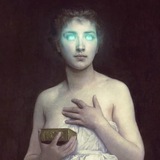EDGY ART
22 Jan 2024 16:00
"The Resurrection of Christopher Carion"
Clive Barker, 2007.
𝓔𝓭𝓰𝓲 𝓐𝓻𝓽
Читать полностью…
EDGY ART
21 Jan 2024 16:00
Enrique Lombardo, "She had a heart!", 1890.
𝓔𝓭𝓰𝓲 𝓐𝓻𝓽
Читать полностью…
EDGY ART
20 Jan 2024 16:00
The aesthetics of the retro anime "Ninja Manuscript" 1993
𝓔𝓭𝓰𝓲 𝓐𝓻𝓽
Читать полностью…
EDGY ART
19 Jan 2024 16:00
"The Ugly Duchess"
Quentin Masseys
𝓔𝓭𝓰𝓲 𝓐𝓻𝓽
Читать полностью…
EDGY ART
18 Jan 2024 16:00
Jean-Pierre Ceytaire
𝓔𝓭𝓰𝓲 𝓐𝓻𝓽
Читать полностью…
EDGY ART
17 Jan 2024 16:00
"Nebuchadnezzar."
William Blake, 1805.
Blake emphasizes in every possible way the transition of man into an animal state. The muscular body of the hero clearly indicates that this is not a beast, but a formerly great man. But the torso is covered with hair, more like bare muscles, and the nails on the hands and feet turn into claws.
Nebuchadnezzar's human eyes attract the viewer's attention most of all: he looks downward, and his face is distorted with shock and disgust.
𝓔𝓭𝓰𝓲 𝓐𝓻𝓽
Читать полностью…
EDGY ART
16 Jan 2024 16:01
Tomasz Setowski
𝓔𝓭𝓰𝓲 𝓐𝓻𝓽
Читать полностью…
EDGY ART
15 Jan 2024 16:00
Dance with the devil
𝓔𝓭𝓰𝓲 𝓐𝓻𝓽
Читать полностью…
EDGY ART
14 Jan 2024 10:00
"Suffering" (1878) is one of the most popular works in the National Gallery of Victoria (Melbourne, Australia)
A sheep stands in front of its dead lamb and cries out in grief. They are already surrounded by crows, and the muted hues convey an atmosphere of hopelessness.
𝓔𝓭𝓰𝓲 𝓐𝓻𝓽
Читать полностью…
EDGY ART
13 Jan 2024 10:28
Fernando Botero
𝓔𝓭𝓰𝓲 𝓐𝓻𝓽
Читать полностью…
EDGY ART
11 Jan 2024 16:00
Author Murαt Yildiym
𝓔𝓭𝓰𝓲 𝓐𝓻𝓽
Читать полностью…
EDGY ART
11 Jan 2024 09:00
Do you enjoy reading this channel?
Perhaps you have thought about placing ads on it?
To do this, follow three simple steps:
1) Sign up: https://telega.io/c/edgyart
2) Top up the balance in a convenient way
3) Create an advertising post
If the topic of your post fits our channel, we will publish it with pleasure.
Читать полностью…
EDGY ART
10 Jan 2024 10:25
"Burning Giraffes and Telephones"
Salvador Dalí, 1937.
In Dalí's symbolic series, the burning giraffe is an image of the coming war. It appears on Dalí's canvases on the eve of the Second World War
𝓔𝓭𝓰𝓲 𝓐𝓻𝓽
Читать полностью…
EDGY ART
07 Jan 2024 10:00
"Tower of Blue Horses"
Franz Marc, 1913.
𝓔𝓭𝓰𝓲 𝓐𝓻𝓽
Читать полностью…
EDGY ART
06 Jan 2024 10:00
The Kiss of Death is a marble sculpture created in 1930 at the Poblenou Cemetery in Barcelona, Spain
𝓔𝓭𝓰𝓲 𝓐𝓻𝓽
Читать полностью…

 2852
2852